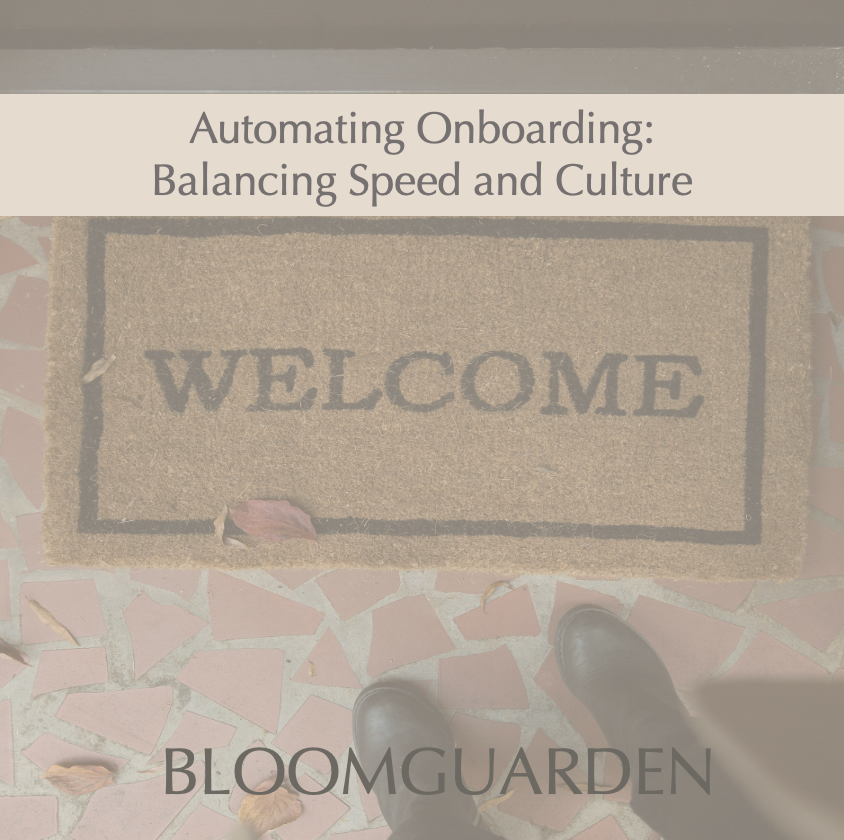Automating Onboarding: Balancing Speed and Culture
Automating Onboarding: Balancing Speed and Culture
First impressions matter—especially in high-growth environments where hiring velocity is high and HR teams are stretched. Onboarding is often where mid-sized companies fall into one of two traps: either it’s slow, inconsistent, and frustrating… or it’s fast, automated—and forgettable.
The sweet spot lies somewhere in between. The best onboarding programs use automation to drive consistency and efficiency, while preserving the human touch that builds culture, trust, and momentum.
This article explores what can (and should) be automated in onboarding, what still requires human investment, and how to strike the right balance—especially for companies scaling fast or operating with lean People Ops teams.
What Automation Can (and Should) Handle
A strong onboarding program contains dozens of repeatable tasks—and automation is your best ally in getting them right, every time.
1. Preboarding Logistics
Before day one, automation can manage:
· Welcome emails and IT checklist confirmations
· Form I-9/E-Verify reminders and document collection
· Benefits enrollment links and deadline tracking
· Delivery of laptop and equipment with shipping notifications
These systems reduce manual coordination, create predictability, and give new hires confidence that your company is operationally sound.
2. Task & Timeline Coordination
Automated workflows (via platforms like Sapling, BambooHR, or Rippling) help sequence:
· Role-specific onboarding tasks by function
· Manager responsibilities (e.g., calendar invites, intros)
· Nudges for check-ins at 30/60/90 days
This avoids the classic “who’s responsible for what?” confusion, especially in distributed or hybrid teams.
3. Knowledge Transfer and Policy Access
Onboarding portals can house:
· Asynchronous training modules
· Employee handbooks and compliance policies
· Videos or org charts explaining team structure
These resources are scalable and help new hires ramp without waiting on live meetings.
Where Culture Still Needs a Human Touch
Automation can’t build relationships, and it can’t teach cultural nuance. Here’s what still needs personal investment:
1. Connection to People
· Live welcome calls or lunches with cross-functional teams
· Executive meet-and-greets
· Buddy or mentor programs to provide informal support
2. Clarity of Expectations
· 1:1 conversations about role, goals, and success criteria
· Feedback sessions during the first 30–60 days
· Real-time support when early friction points arise
3. Cultural Signal Moments
· Sharing company stories, traditions, or wins in a live format
· Reinforcing values through leader behavior, not just slide decks
· Demonstrating psychological safety through vulnerability and listening
Culture is caught, not taught—and that only happens through human interaction.
Red Flags: When Automation Goes Too Far
· Overloading day one: Too many emails, portals, or logins without context makes onboarding feel like homework.
· “Set and forget” workflows: Tasks get stale fast. Automated sequences must evolve as the org changes.
· No space for questions: If everything is self-guided, new hires may feel unsupported or invisible.
· Culture as content: Values videos and Slack intros don’t replace actual interaction or shared experience.
Best Practices for a Balanced Onboarding Program
· Use automation to standardize tasks, not relationships
· Design day one to be emotionally grounding—not just administratively efficient
· Check in early and often: Don’t wait until day 90 to know if someone’s struggling
· Customize by function: Ops onboarding ≠ Sales onboarding
· Co-own onboarding: Make it clear what HR owns vs. what managers lead
Conclusion
Onboarding is more than orientation. It’s the beginning of engagement, trust, and belonging. Automating the logistics buys back time—but the culture work still has to be done, and it has to be human.
For mid-sized companies trying to scale culture without sacrificing speed, the goal isn’t to choose between automation and warmth. It’s to build both, intentionally.
References
· SHRM. (2023). Employee Onboarding Guide: The 4 C’s of Successful Onboarding.
· Harvard Business Review. (2022). Why Onboarding Fails—and How to Fix It.
· BambooHR. (2023). State of Onboarding Report.
· Gallup. (2023). The First 90 Days: How Onboarding Affects Engagement and Retention.
· Workato. (2024). Automated Employee Onboarding: What to Automate and What to Humanize.
How BloomGuarden Can Help
At BloomGuarden, we help HR teams streamline onboarding systems while preserving the culture-building moments that matter. Whether you're launching automation tools or refreshing your onboarding strategy, we help you scale clarity and connection—together.
📩 Email us at contact@bloomguarden.com to learn more or get a walkthrough of our onboarding design playbook.
